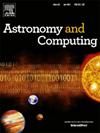The evolutionary path of star-forming clumps in Hi-GAL
IF 1.8
4区 物理与天体物理
Q2 ASTRONOMY & ASTROPHYSICS
引用次数: 0
Abstract
Star formation (SF) studies are benefiting from the huge amount of data made available by recent large-area Galactic plane surveys conducted between and 3 mm. Fully characterizing SF demands integrating far-infrared/sub-millimetre (FIR/sub-mm) data, tracing the earliest phases, with near-/mid-infrared (NIR/MIR) observations, revealing later stages characterized by Young Stellar Objects (YSOs) just before main sequence star appearance. However, the resulting dataset is often a complex mix of heterogeneous and intricate features, limiting the effectiveness of traditional analysis in uncovering hidden patterns and relationships. In this framework, machine learning emerges as a powerful tool to handle the complexity of feature-rich datasets and investigate potential physical connections between the cold dust component traced by FIR/sub-mm emission and the presence of YSOs. We present a study on the evolutionary path of star forming clumps in the Hi-GAL survey through a multi-step approach, with the final aims of (a) obtaining a robust and accurate set of features able to well classify the star forming clumps in Hi-GAL based on their evolutionary properties, (b) establishing whether a connection exists between the cold material reservoir in clumps, traced by FIR/sub-mm emission, and the already formed YSOs, precursors of stars. For these purposes, our designed experiments aim at testing whether the FIR/sub-mm properties related to clumps are sufficient to predict the clump evolutionary stage, without considering the direct information about the embedded YSOs at NIR/MIR. Our machine learning-based method involves a four-step approach, based on feature engineering, data handling, feature selection and classification. This workflow ensures the identification of the most relevant features driving the SF process, and rigorously evaluates the results through a classification analysis. Our findings suggest that FIR/sub-mm and NIR/MIR emissions trace different evolutionary phases of star forming clumps, highlighting the complex and asynchronous nature of the SF process.
Hi-GAL中恒星形成团块的演化路径
恒星形成(SF)研究得益于最近在2μm至3 mm之间进行的大面积银河面调查所提供的大量数据。充分表征SF需要整合远红外/亚毫米(FIR/sub-mm)数据,追踪早期阶段,与近红外/中红外(NIR/MIR)观测,揭示后期阶段的特征,即在主序星出现之前的年轻恒星天体(YSOs)。然而,结果数据集通常是异构和复杂特征的复杂混合,限制了传统分析在发现隐藏模式和关系方面的有效性。在这个框架中,机器学习成为一个强大的工具,可以处理特征丰富的数据集的复杂性,并研究FIR/亚毫米辐射追踪的冷尘埃成分与YSOs存在之间的潜在物理联系。我们通过多步骤方法对Hi-GAL调查中恒星形成团块的演化路径进行了研究,最终目的是(a)获得一组可靠而准确的特征,能够根据其演化特性对Hi-GAL中的恒星形成团块进行分类,(b)确定团块中的冷物质储藏库(由FIR/亚毫米发射追踪)与已经形成的yso(恒星的前体)之间是否存在联系。为此,我们设计的实验旨在测试与团块相关的FIR/sub-mm特性是否足以预测团块演化阶段,而不考虑近红外/MIR中嵌入的yso的直接信息。我们基于机器学习的方法包括四步方法,基于特征工程、数据处理、特征选择和分类。该工作流确保识别驱动SF过程的最相关特性,并通过分类分析严格评估结果。我们的研究结果表明,FIR/sub-mm和NIR/MIR发射追踪了恒星形成团块的不同进化阶段,突出了SF过程的复杂性和异步性。
本文章由计算机程序翻译,如有差异,请以英文原文为准。
求助全文
约1分钟内获得全文
求助全文
来源期刊

Astronomy and Computing
ASTRONOMY & ASTROPHYSICSCOMPUTER SCIENCE,-COMPUTER SCIENCE, INTERDISCIPLINARY APPLICATIONS
CiteScore
4.10
自引率
8.00%
发文量
67
期刊介绍:
Astronomy and Computing is a peer-reviewed journal that focuses on the broad area between astronomy, computer science and information technology. The journal aims to publish the work of scientists and (software) engineers in all aspects of astronomical computing, including the collection, analysis, reduction, visualisation, preservation and dissemination of data, and the development of astronomical software and simulations. The journal covers applications for academic computer science techniques to astronomy, as well as novel applications of information technologies within astronomy.
 求助内容:
求助内容: 应助结果提醒方式:
应助结果提醒方式:


